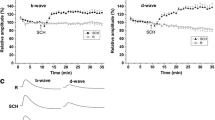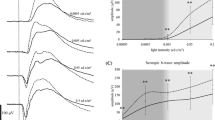Abstract
Previous reports have shown that an intravitreal injection of 2-amino-4-phosphonobutyric acid, a glutamate analogue that selectively blocks the photoreceptors' input to the on-bipolar cells, produces a rapid decrease in the amplitude of the electroretinographic b-wave. To our knowledge, the effect of this glutamate analogue has not been examined on the oscillatory potentials. We therefore conducted such a study. A needle electrode was inserted into the anterior chamber of the eyes of seven anesthetized and paralyzed rabbits to record simultaneously the electroretinogram and the oscillatory potentials. These responses were evoked by flashes of white light delivered in mesopic conditions. As expected, an injection of 2-amino-4-phosphonobutyric acid, produced a rapid decrease in the amplitude of the b-wave, while the a-wave was relatively spared. The amplitude of the oscillatory potentials also decreased rapidly. At maximal effect, the electroretinogram essentially consisted of a normal a-wave followed by small oscillations and no evidence of a b-wave. The 100–1000 Hz recording confirmed that the oscillations seen on the postinjection electroretinograms were remnants of the original oscillatory potentials.
Similar content being viewed by others
References
Slaughter MM, Miller RF. 2-amino-4-phosphonobutyric acid: A new pharmacological tool for retina research. Science 1981; 211: 182–84.
Schiller PH. Central connections of the retinal on and off pathways. Nature 1982; 297: 580–83.
Neal MJ, Cunningham JR, James TA, Joseph M, Collins JF. The effect of 2-amino-4-phosphonobutyrate (APB) on acetylcholine release from the rabbit retina: evidence for on-channel input to cholinergic amacrine cells. Neurosci Lett 1981; 26: 301–5.
Massey SC, Redburn DA. The cholinergic amacrine cells of rabbit retina receive on and off input: an analysis of [3H]-Ach release using 2-amino-4-phosphonobutyric acid (APB) and chloride free medium. Vision Res 1983; 23: 1615–20.
Arkin MS, Miller RF. Subtle actions of 2-amino-4-phosphonobutyrate (APB) on the off pathways in the mudpuppy retina. Brain Res 1987; 426: 142–8.
Dick E, Miller RF. Light-evoked potassium activity in mudpuppy retina: its relationship to the b-wave of the electroretinogram. Brain Res 1978; 154: 388–94.
Knapp AG, Schillerl PH. The contribution of on-bipolar cells to the electroretinogram of rabbits and monkeys: a study using 2-amino-4-phosphonobutyrate (APB). Vision Res 1984; 24: 1841–46.
Lachapelle P. Analysis of the photopic electroretinogram recorded before and after dark adaptation. Can J Ophthalmol 1987; 22: 354–61.
Massey SC, Redburn DA, Crawford MLJ. The effects of 2-amino-4-phosphonobutyric acid (APB) on the ERG and ganglion cell discharge of rabbit retina. Vision Res 1983; 23: 1607–13.
Zimmerman RP, Corfman TP. A comparison of the effects of isomers of alpha-aminoadipic acid and 2-amino-4-phosphonobutyric acid on the light response of the Muller glial cell and the electroretinogram. Neuroscience 1984; 12: 77–84.
Porciatti V, Bagnoli P, Alesci R, Fontanesi G. Pharmacological dissociation of the b-wave and pattern electroretinogram. Doc Ophthalmol Proc Ser 1987; 65: 377–83.
DeMarco PJ, Nussdorf JD, Brockman DA, Powers MK. APB selectively reduces visual responses in goldfish to high spatiotemporal frequencies. Visual Neurosci 1989; 2: 15–18.
Knapp AG, Ariel M, Robinson FR. Analysis of vertebrate eye movements following intravitreal drug injections. I. Blockade of retinal on-cells by 2-amino-4-phosphonobutyrate eliminates optokinetic nystagmus. J Neurophysiol 1988; 60: 1010–21.
Speros P, Price J. Oscillatory potentials: history, techniques and potential use in the evaluation of disturbances of retinal circulation. Surve Ophthalmol 1981; 25: 237–52.
Nagata M. Studies on the photopic ERG of the human retina. Jpn J Ophthalmol 1963; 7: 96–124.
Kojima M, Zrenner E. Off-components in response to brief light flashes in the oscillatory potential of the human electroretinogram. Graefes Arch Clin Exp Ophthalmol 1978; 206: 107–20.
Wachtmeister L. Further studies of the chemical sensitivity of the oscillatory potentials of the electroretinogram (ERG): I. GABA-and glycine antagonists. Acta Ophthalmol 1980; 58: 717–25.
Wachtmeister L. Further studies of the chemical sensitivity of the oscillatory potentials of the electroretinogram (ERG): II. Glutamate, aspartate and dopamine antagonists. Acta Ophthalmol 1981a; 59: 247–258.
Wachtmeister L. Further studies of the chemical sensitivity of the oscillatory potentials of the electroretinogram (ERG): III. Some omega-aminoacids and ethanol. Acta Ophthalmol 1981b; 59: 609–619.
Lachapelle P. Oscillatory potentials (letter to the editor). Arch Ophthalmol 1985; 103:480.
Lachapelle P, Molotchnikoff S. Components of the electroretinogram: a reappraisal. Doc Ophthalmol 1986; 63: 337–48.
Author information
Authors and Affiliations
Rights and permissions
About this article
Cite this article
Guité, P., Lachapelle, P. The effect of 2-amino-4-phosphonobutyric acid on the oscillatory potentials of the electroretinogram. Doc Ophthalmol 75, 125–133 (1990). https://doi.org/10.1007/BF00146548
Received:
Accepted:
Issue Date:
DOI: https://doi.org/10.1007/BF00146548




